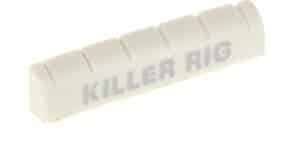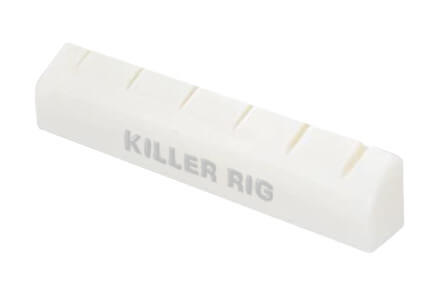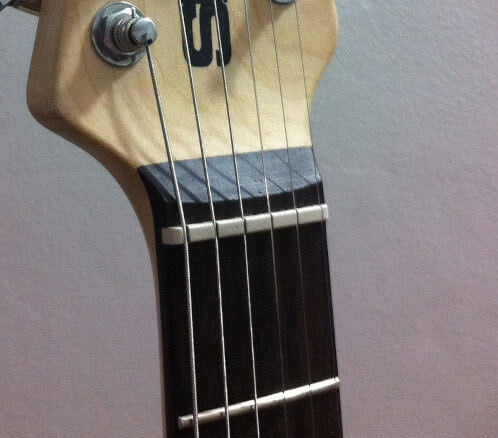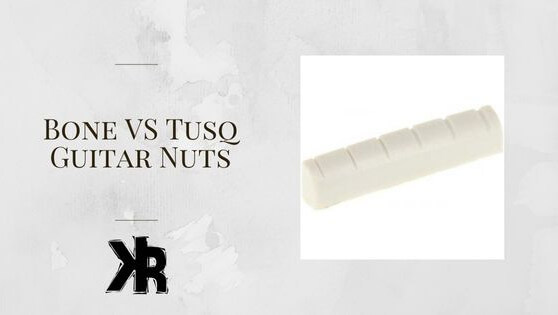Table of Contents
There are many materials used to make guitar nuts. Bone and Tusq are two of the most popular and are the first choice for guitar players and manufacturers. Each has its own advantages and disadvantages.
The main difference is that Tusq is a synthetic material and bone is natural. As a result, Tusq nuts are a more consistently dense material.
But bone can vary in density and can often have random soft spots. Tusq is also slightly more affordable and self-lubricating. These are excellent traits for a guitar.
In this Killer Rig article, we are going to explore the difference between bone vs tusq nuts. Let’s see which is the best option for an electric or acoustic guitar.
What is Tusq?
Tusq is a man-made material created by Dave Dunwoodie at Graph tech. It’s designed to mimic the properties of ivory and is used in a variety of applications.
This includes guitar nuts, bridge pins, picks, saddles, and more. Tusq is made from a polymer resin and is designed to be like ivory.

It’s a popular material for musical instruments. This is because it produces a rich, resonant tone.
Tusq is also more durable than bone or ivory, as it has no soft spots in the material. Many guitar manufacturers now use it on their instruments as standard equipment.
Why Use Bone?
Bone has a long history of use in musical instruments. It’s still widely considered the best material for nuts and saddles.
Many high-end guitars still use bone nuts and saddles. This is because they produce a richer, more resonant tone. At least when compared to other materials like plastic.

Bone is also easy to source, as it’s normally taken from cows or camels, which are natural materials. Some people still prefer to use bone over man-made materials like Tusq.
Bone Vs Tusq Nut
Tusq and bone are two of the most popular materials used for acoustic and electric guitar nuts today. They each have their own unique benefits and drawbacks. It’s important to choose the right nut material for your instrument.
Tusq nuts are made from a synthetic polymer, which gives them a smooth and consistent tone.
They’re also very durable and solid throughout. This makes them a good choice for players who are hard on their instruments.
Bone nuts, on the other hand, are made from real animal material. This means they are not as consistent as Tusq and can have soft spots in places.
As a result, bone guitar nuts can be more difficult to work with and degrade unevenly over time.
Do They Sound Different?
Tusq and bone nuts are basically the same in sound. They are both designed to produce a rich, resonant tone. There is a slight difference in the way they each handle overtones.
But it’s not significant enough to make a real difference in your sound. And once you fret a string, the nut doesn’t have anymore to do with the sound. They only contribute when guitar strings are played open.
Tusq does produce a slightly different sound when dropped loosely on a table. It has a more rigid ring upon impact when compared to a bone nut under the same test.
And because some bone nuts may have soft spots within the material, the tone can be affected to a slight degree.
To my ear, there really isn’t a difference in sound. So I would select one of these materials based on durability and the ability to source them.
Which One Is Better For Guitars?
In my opinion, Tusq is a better choice for guitar nuts. It’s more durable and solid. Which means it can handle more abuse.
It’s also self-lubricating. This is great for helping the strings move across the surface. It’s perfect for tuning stability and intonation.
Bone nuts are more fragile and can be difficult to work with. They’re also not as consistent in tone, which can affect your sound if you get a bad blank. They will also wear out unevenly in this case, which will affect the sound of some of the strings.
How Can You Tell if Your Guitar has a Tusq or Bone Nut?

Not sure whether your guitar has a Tusq or bone nut? The best way to find out is to look at the manufacturer’s website. They will usually list the materials used on their instruments.
If that is not possible, there are a couple of other things to look for:
- If your guitar has a bone nut, it will usually be a slightly off-white color. Tusq nuts, on the other hand, have a more uniform color and are normally either black or white.
- A bone nut will look rougher on the surface. This is what you would expect it to look like. Tusq looks more like a shiny plastic with a larger radius on the edges.
Just keep in mind that if you have a cheaper guitar and the nut looks like plastic, then it probably is.
Is Bone More Expensive Than Tusq?
Bone is more expensive than Tusq, as it’s a natural product. Bone nuts can cost anywhere from 15 to $30. While Tusq nuts are usually around 12 to $20.
Manufacturers have started to use tusq on their entry-level guitar models. This is because the price is low, and the quality is excellent.
For a player looking to replace the nut on an old guitar, the price really won’t be a big factor. At least in deciding on which material to go with.
Conclusion
Tusq and bone are two of the most popular materials used for guitar nuts today. They each have their own unique benefits and drawbacks.
In the end, the best material to use for your guitar nut is the one that you like more. For us, that is Tusq, for you, it might not be. But either material is still better than plastic!
FAQs
Is Tusq a bone?
No, Tusq is a synthetic polymer material that was designed to mimic the sound and feel of bone. Bone is a natural material and is not as consistent in density as tusq.
How long do bone nuts last?
Bone nuts can last for many years, but they will eventually start to wear down. The wear pattern will be uneven, and you may notice that some of the strings start to sound different.
What type of bone are guitar nuts made from?
Guitar nuts are usually made from cow, camel, or buffalo bone. They are normally from larger animals that are easy to harvest with dense bones.

